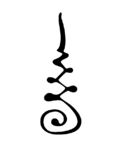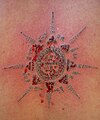Yantra tattooing
Yantra tattooingorSak Yantis a form oftattooingusing Indianyantradesigns. It consists of sacred geometrical, animal and deity designs accompanied byPaliphrases that are said to offer power, protection, fortune, charisma and other benefits for the bearer.
History
[edit]Tattoos believed to offer protection and other benefits have been recorded everywhere throughout bothmainland Southeast Asiaand as far south asIndonesiaand thePhilippines.[1]Over the centuries the tradition spread to what is nowCambodia,Laos,Thailand,and parts ofMyanmar.[2]While the tradition itself originates with indigenous tribal animism, it became closely tied to theHindu-Buddhistconcept ofyantraor mystical geometric patterns used during meditation. Tattoos of yantra designs were believed to hold magic power, and were used much like thekolamtattoos of India. For these people, religion is closely tied to the notion of magic, health, and good fortune.[3]
The script used for yantra designs varies according to culture and geography. In Cambodia and central Thailand, the OldKhmer script(Cambodian language) of theKhmer Empireis used. While in northern Thailand yantra tattoos may useShan,northern Thai, orTai Luscripts, and in Laos theLao Thamscript is employed.[4][5][6][7]The script spells out abbreviated syllables fromPaliincantations. Different masters have added to these designs over the centuries through visions received in their meditations. Some yantra designs have been adapted from pre-Buddhistshamanismand the belief inanimal spiritsthat was found inSoutheast Asiaand incorporated into Thai tradition and culture.[8]
Meaning
[edit]Yantra tattoos are believed to be magic and bestow mystical powers, protection, or good luck.[9]There are three main effects of a yantra tattoo. One is that which benefits the wearer, such as making them more eloquent. Another is that of protection and to ward off evil and hardship. This is commonly used by military personnel, police, taxi drivers, gangsters, and others in perceived dangerous professions. Another type is that which affects people around the wearer, such as invoking fear. The tattoo only confers its powers so long as the bearer observes certain rules and taboos, such as abstaining from a certain type of food.[1]
Sak yant designs are also applied to many other media, such as cloth or metal, and placed in one's house, place of worship, or vehicle as a means of protection[citation needed]from danger or illness, to increase wealth, and to attract lovers. In recent years Hollywood celebrities such asAngelina Jolie,whose tattoos were inked by Ajahn Noo Ganpai with Old Khmer script Sak yant in Thailand, have made them popular among women.[4]Angelina Jolie got a yantra tattoo of a Bengal tiger in 2004 to celebrate acquiring Cambodian citizenship.[10]
However, a modern movement in Thailand seeks to progress away from its animistic past. As part of this movement, many modern-day Thais view yantra tattoos as nothing more than good-luck symbols that are stylish.[11]
Types and designs
[edit]

There are thousands of traditional designs of yantra tattoos, but some of the most well-known and popular include:
- Ong Phra(Thai:องค์พระ;translation:Buddha's body) - one of the most commonly used elements in Yantra tattooing, but can also be a more complex standalone design. Meant to provide insight, guidance, illumination, etc.
- Haw-taew(Thai:ห้าแถว;translation:five rows) - Typically tattooed on the back left shoulder. Each of the five lines relates to a different blessing for success and good luck.
- Gao-yord(Thai:เก้ายอด;translation:nine spires) - typically tattooed on the center top of the back in various sizes and levels of complexity. Simple version pictured at the top of this article.
- Si-yot(Thai:สี่ยอด;translation:four spires) - to influence the feelings or actions of others and protect the bearer.
- Paed-thit(Thai:แปดทิศ;translation:eight points) - represents protection in the eight directions of the universe. Round shape; typically tattooed on the center of the back. Pictured in gallery below.
- Sip-thit(Thai:สิบทิศ;translation:ten points) - a version ofpaet-thit,but protects in ten directions instead of eight.
- Maha-niyom(Thai:มหานิยม;translation:great preference) - to grant the bearer favor in the eyes of others. Round shape; typically placed on the back right shoulder.
- Yot Mongkut(Thai:ยอดมงกุฎ;translation:spired crown) - for good fortune and protection in battle. Round shape; typically tattooed on the top of the head.
- Panchamukhi(Thai:ปัญจมุขี;translation:five Deva faces) - intended to ward off illness and danger.
- Suea-koo(Thai:เสือคู่;translation:twin tiger) - typically depicts twin tigers. Symbolizes strength, fearlessness, and resilience.
- Uṇālom(Thai:อุณาโลม;translation:urna,often left untranslated as "unalome" ) - the ūrṇā curl between the eyebrows of the Buddha. Variously described as representing the 'third eye', the path tonirvana,and the coil, line, and point of the syllable 'Om' written inThai script.
- Hanuman(Thai:หนุมาน;translation:monkey god) - Hanuman is revered for his ability to overcome obstacles and challenges, making the Hanuman Yantra a symbol of resilience and determination.
- Yant Krop Kaew(Thai:ยันต์กรอบแก้ว;translation:diamond shield) - features geometric patterns resembling a diamond or crystal lattice, symbolizing strength and invincibility.[12]
Locations
[edit]- One of the most famous temples in the present day for yantra tattooing isWat Bang PhrainNakhon Chai Si District,Nakhon Pathom Province,Thailand. Ajaan Noo Kanpai, perhaps the most famous practitioner of sak yan in Thailand, trained here.
- One well-known temple in northern Thailand is Wat Nhong Khem (khemmeans needle).[13]It is in San Patong just outsideChiang Maiand was home to the late sak yan master Phra Ajaan Gamtawn, who died in Chiang Mai on 14 September 2010. This temple no longer applies tattoos.[14]
Gallery
[edit]-
Yant Paed-thit
-
Phra Ajarn Hlwong Pi Nan tattooing atWat Bang PhraTemple
-
Hlwong Pi Pant tattooing a yant inAng Thong Province.
-
Devotee of Wat Bang Phra covered in sak yant
-
Sak yant, Nakhon Pathom
See also
[edit]References
[edit]- ^abLars Krutak.Spiritual Skin: Magical Tattoos and Scarification.Reuss.ISBN9783943105117.
- ^Cummings, Joe, (2011)Sacred Tattoos of Thailand: Exploring the Magic, Masters and Mystery of Sak Yan,Marshall Cavendish.
- ^Drouyer, Isabel Azevedo; Drouyer, Rene, (2013)Thai Magic Tattoos, The Art and Influence of Sak Yant,Riverbooks editions.
- ^abCummings, Joe. (2015).Sacred Tattoos of Thailand: Exploring the Magic, Masters and Mystery of Sak Yan.ISBN9814302546See also[1]
- ^May, Angela Marie. (2014).Sak Yant: The Transition from Indic Yantras to Thai Magical Buddhist Tattoos (Master's thesis).The University of Alabama at Birmingham.
- ^Igunma, Jana. (2013). Aksoon Khoom: Khmer Heritage in Thai and Lao Manuscript Cultures.Tai Culture, 23, Route of the Roots: Tai-Asiatic Cultural Interaction.
- ^Kourilsky, Grégory, & Berment, Vincent. (2005). Towards a Computerization of the Lao Tham System of Writing. InFirst International Conference on Lao Studies (FICLS).
- ^Bangpra, Tik (September 8, 2020).The Power Of Sak Yant: 50 Designs & Meanings Of Thai Tattoos(1 ed.). Independently published. p. 1.ISBN979-8683996604.Retrieved13 June2021.
- ^"Sak Yant - Magic Tattoo | Thai Guide to Thailand".Archived fromthe originalon 2011-10-01.Retrieved2010-03-12.
- ^Angelina Jolie Has Three Giant New Tattoos. (2016, February 9). SELF. Retrieved February 2, 2021, fromhttps:// self /story/angelina-jolie-new-tattoos
- ^"Tattoo Chiang Mai - Your destination in northern Thailand".thai.tattoo.Retrieved2017-04-02.
- ^"Sak Yant: Muay Thai Tattoos & Meaning".Siamkick Fight.RetrievedMarch 28,2024.
- ^"Sak Yant - at Wat Nhong Khaem".Archived fromthe originalon 2016-08-14.Retrieved2010-02-12.
- ^"Phra Ajarn Gamtorn-Sak Yant Chiang Mai - R.I.P. | Thai Guide to Thailand".Archived fromthe originalon 2016-11-07.Retrieved2010-09-16.
Further reading
[edit]- Chean Rithy Men. "The Changing Religious Beliefs and Ritual Practices among Cambodians in Diaspora", inJournal of Refugee Studies.Vol. 15, No. 2 2002, pp 222–233.
- Cummings, Joe.Sacred Tattoos of Thailand: Exploring the Masters, Magic and Mystery of Sak Yan.Singapore, 2011.
- Drouyer, Isabel; Drouyer, Rene.Thai Magic Tattoos The Art And Influence of Sak Yant.Ed. River Books, 2013.
- Harris, Ian.Cambodian Buddhism: History and Practice.Honolulu, 2008.
- Igunma, Jana. "Human Body, Spirit and Disease; the Science of Healing in 19th century Buddhist Manuscripts from Thailand", inThe Journal of the International Association of Buddhist Universities.Vol. 1, 2008, pp. 120–132.
- Rivers, Victoria Z. "Layers of Meaning: Embellished Cloth for Body and Soul", inJasleen Dhamija,Asian Embroidery.New Delhi, 2004, pp. 45–66.ISBN81-7017-450-3.
- Swearer, Donald K.Becoming the Buddha: the Ritual of Image Consecration in Thailand.Princeton, 2004.





